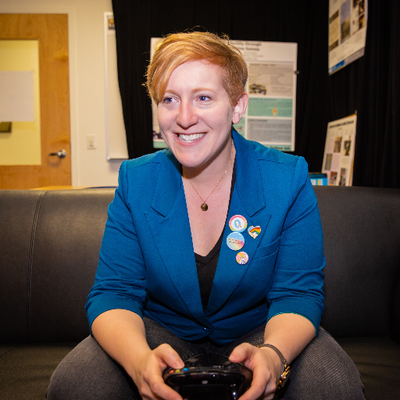Things are still winding down from the wonder that was the Queerness and Games Conference. Video of the talks is now available online. Many touching thank-yous have been sent and received. Polygon’s Danielle Riendeau and UC Berkeley’s Daily Californian both honored us with thoughtful, insightful write-ups. My favorite quote, from Danielle: “I can’t imagine something like this existing ten — or even five — years ago, but now, I can’t imagine a future without it and other similar events.”
In that spirit, it’s been important to us to find ways to keep the ball rolling, and that means sharing what we learned from the event so that others can create their own inclusive, alternative games conferences. In my last post, I outlined our event budget. This time I want to talk about our major steps and timeline. The short version: the event, which was held at the end of October, 2013, took about nine months to create. Communication, organization, persistence, and a diverse and dedicated team of organizers was crucial. Here was our process, broken down into 10 steps:
1. The idea (December, 2012). “What we need is a conference about queerness and games!” proclaims Bonnie in a fit of wide-eyed idealism. Finding your idea means more than enthusiasm though. It also means knowing the field. Does your topic interest others? Is it currently underserved by the community? Can you imagine it becoming a conference?
2. The organizers (February, 2013). The Queerness and Games Conference didn’t become real until it had a strong team of organizers. For us diversity was key. By chatting with friends, listening through the grapevine, and reaching out into the unknown, we ended up with the perfect team that bridged academics and game development.
3. The date and location (March, 2013). The earlier you can lock down your days and your venue, the better. Knowing helped up present a concrete plan to potential speakers and sponsors.
4. Web presence and registration (March, 2013). Having a website and Twitter feed as soon as possible gave us somewhere to send people who wanted to learn more about the event. We used pretty basic tools for this, like WordPress and Eventbrite, so that the organizers could leap into creating our web presence as fast and easily as possible.
5. Writing the CFP and soliciting speakers (April, 2013). A call for papers is pretty standard in conference land. For us, however, we had a few different types of person to appeal to: academics, game developers, etc. We ended up writing an academic CFP as well as an adapted version for the website. We sent this out through public channels, and we also used it when we contacted individuals who we thought would make rad participants.
6. Funding (April, 2013). As I’ve mentioned, all of our funding came from university departments. We emailed or spoke to department heads individually, followed up doggedly, and made sure that our endless paperwork was in order.
7. Selecting and scheduling talks (July, August, September 2013). This takes a long time, in part because it requires being in regular contact with a lot of people. Our speakers had to submit their abstracts by July. In August we sent them feedback. In September we began collecting info on who was definitely coming, when they could speak, etc. By the end of September our schedule was set.
8. The volunteers (September, 2013). Also in September we tracked down volunteers. We found that doing a general online call for volunteers wasn’t too successful, but asking our friends, family, and coworkers turned up some amazing people.
9. Advertise, advertise, advertise (October, 2013). In a way, we’d been advertising through our web presence since the spring, but we definitely stepped up our game in the month before the conference. We had flyers, post cards, and posters — yes, like made of dead trees — that we plastered around campus. We sent out emails to related university departments. We posted a ton of friendly reminders on our Twitter feed.
10. Crunch time (late October, 2013). And then everything happened at once. In the final weeks we were active all the time: designing and printing the programs, locking down the catering, managing last-minute speaker crises, etc. This was definitely a good time to have blocked out with no other obligations.
Conference time! October 25 – 27, 2013. Also, we’re finding that It’s good to plan for about a month of post-conference work as well. This, so far, has involved things like getting speakers their honorariums, posting online content, and writing follow-up pieces like this one.
Yes, all in all, it’s a lot of hard work, but it’s totally worth it, and (with patience, passion, and a team of awesome people) it’s very doable. Now YOU try, because we want to hang out at your conferences.

